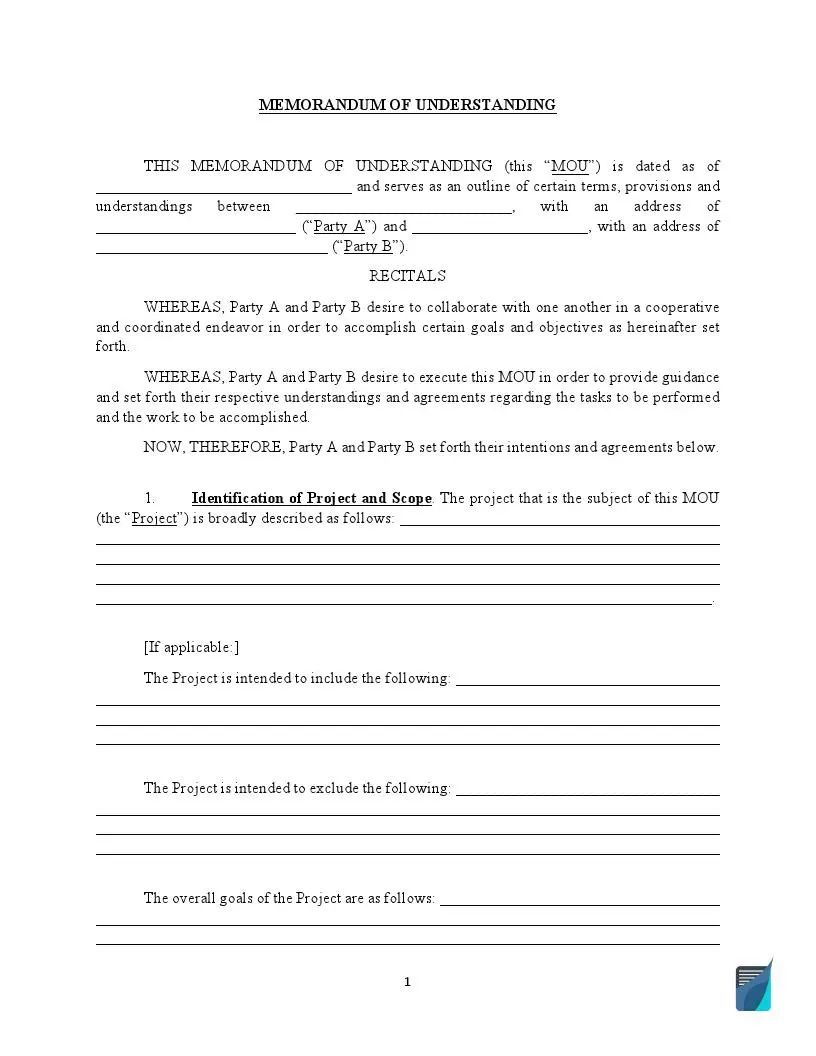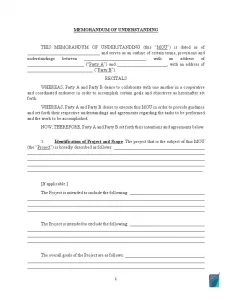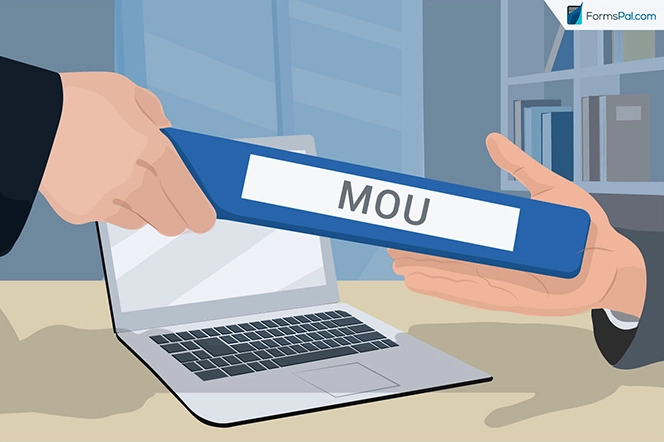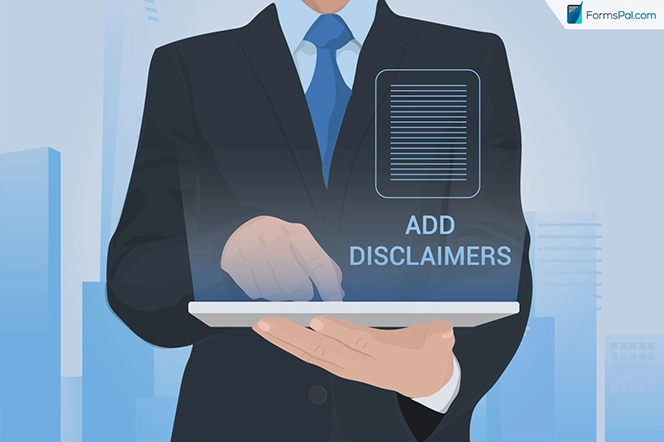
A memorandum of understanding (MOU or MoU) is a document between two or more parties defining the expectations, roles, conditions, and warranties within a mutual project. Usually, it is not legally enforceable, but the parties, if desired, may use one as a binding document in certain cases.
If you want to prepare your memorandum easily, please use our memorandum of understanding template. You can use the information there as a sample and add a part of your terms. You are also encouraged to take advantage of our guidelines. They will help you to customize the template with no problems.

Create a free high quality Memorandum of Understanding online now!
Build Your Document
Answer a few simple questions to make your document in minutes
Save progress and finish on any device, download and print anytime
Your valid, lawyer-approved document is ready
. or download your Memorandum of Understanding Template as a PDF file Create a free high quality Memorandum of Understanding online now! Table of ContentsA memorandum of understanding is one of the most popular agreements. Since it does not usually belong to binding contracts, it takes less time to prepare. Therefore, individuals avoid all the red tape connected with a contract long-term preparation.
However, an MOU is a strong declaration of a further relationship between partners. The most common occasions for using the MOU agreement are the following.
By governments
Governments often use MOUs to establish different types of cooperation between countries. They help clearly define the intentions and opportunities of the parties in the strategic fields of activity. For example, the United States has many memoranda on science and technology cooperation with different governments.
By businesses
MOUs can be a useful part of business relationships. The agreement is a good way to promote the company in a specific field, improve its competitiveness, and support economic development. An MOU helps to define all implementation details and state the conditions of anticipated transactions between business partners.
By universities
An MOU is a common practice for universities. It serves as a statement of interest to explore different opportunities for cooperation, including scholar and student exchanges and resource sharing within international projects or grant programs. It also helps universities enter into agreements with private organizations and companies for further internships or scientific cooperation.
A memo of understanding is the first step to broad cooperation. It’s filling the gap between a formal handshake and a binding agreement. Terms of memorandum depend on the occasion when it’s used. It can be brief or more detailed, but each memo should include the next components:

Writing a comprehensive memorandum of understanding can require a lot of effort. You are encouraged to use our templates to make this process more bearable. Along with our guidelines, they allow you to prepare the documents in no time. Please, follow the next steps while preparing your agreement. If you have questions during the process, it is better to address your attorney.
Step 1. Identify the parties

At the beginning of the document, all parties involved in the agreement should be identified. Make sure that either party indicates the right name and address. It is never redundant to make a small introduction and provide background information on each party, mutual promises, or history of the collaborative relationship.
Step 2. Describe the overall purpose

The next important thing is to describe the subject matter and objectives of the memorandum. The memo of understanding is always devoted to a specific mission. Depending on the occasion, it can be aimed at broadening the countries’ scientific communities, promoting the competitiveness of the company and business, or establishing student exchange programs.
Step 3. Define the roles and responsibilities

This section might be the most extensive. Each partner is expected to prepare a sample of the terms in advance and then negotiate them with another party(-ies). You can consult your lawyer on the issue. When you have finished the negotiation stage, you have to describe the partner’s roles and state both individual and shared obligations. It is possible to add relevant services or resources the parties can benefit from in connection to the project. The parties should also name the team representatives from each side, plan the project’s implementation and performance evaluation.
Step 4. Indicate the scope and timeline

It is crucial to identify the effective date and duration of the agreement. If it’s a long-term cooperation, you can indicate the date, after which the memo will be automatically extended. You may include the termination terms, specifying its conditions and how one party shall notify the other, and within what period of time.
Step 5. Add disclaimers

Do not forget to include disclaimers about the memorandum’s financial aspects and general compliance with the state law. Also, if you do not refer to the memo as a binding document, try to make it clear. Otherwise, in case of any breach of the agreement, the court may treat it like a legal contract.
Step 6. Provide other necessary terms

You should look through the memorandum once again and include, where it’s necessary, all the information pertinent to the project. You can add the term about governing law or notice requirements. It’s useful to include information in connection with arbitration and dispute resolution, clarifying how disputes or claims should be settled.
Step 7. Sign the memorandum

Do not forget to leave the space for all the authorized parties to sign the agreement. Signing the memorandum is important because it demonstrates the commitment of all partners to work together to support and achieve the project’s goals.
Usually, it’s not legally binding. The reason partners sign such an agreement is to prepare themselves for further cooperation and provide all the details related to the future contract. However, if the agreement does not clearly state that it does not constitute a contract, the court may treat it as an enforceable document should some claims in connection to the agreement arise.
Although sometimes these documents are used interchangeably, they are not the same. Like a memorandum, a letter of intent regards exchanging ideas and sets out the commitments about all matters relating to the partnership. However, an LOI serves as a ” written handshake” and cannot be legally binding.

With over 25 years of experience as a business and transactional attorney, Jennifer has mastered the craft of closing highly successful deals for her clients. Through her wide-ranging expertise in commercial contracts, real estate transactions, M&A and corporate law, Jennifer secures results that are second-to-none.
Browse documentsCILIARA TRADING LIMITED
Address: Strovolou 77, Strovolos Center, Office 301, 2018 Nicosia, Cyprus
Monday-Friday 2AM - 12PM EDT
© 2024 CILIARA TRADING LIMITED. All rights reserved. CILIARA TRADING LIMITED (“FormsPal”) is not a law firm and is in no way engaged in the practice of law. This website is not intended to create, and does not create, an attorney-client relationship between you and FormsPal. All information, files, software, and services provided on this website are for informational purposes only.